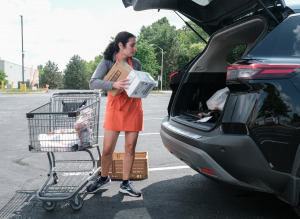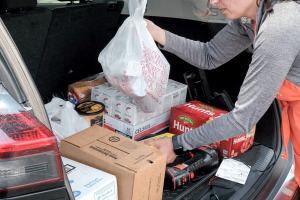Subscriber Benefit
As a subscriber you can listen to articles at work, in the car, or while you work out. Subscribe Now
Gleaners Food Bank of Indiana’s core mission of providing food relief has become a lot more complicated over the past few years, thanks to the pandemic, and the organization is looking to technology to help it navigate its “new normal.”
About 63% of Gleaners’ food is distributed through partner agencies. But for food the organization distributes to people directly (not including mobile pantries), it is now serving four times the number of households that it was in January 2020—about 5,000 a week instead of 1,200. And the organization now offers that food through a combination of drive-through, pickup and home-delivery options rather than its previous model, where people visited Gleaners’ Waldemere Avenue pantry to select what they wanted.

Now, faced with the reality that these post-pandemic shifts are likely here to say, Gleaners sees technology as its path forward.
“One of the things that is a lot more in the front of our minds now than it was pre-pandemic is, we have to do some things differently to get food to people,” said Gleaners Chief Operating Officer Joe Slater. “So we need a new technology engine to power those programs, which are designed to get the food to people versus just rely on the fact that the people can get to the food.”
Gleaners is analyzing its options and hopes to settle on a new technology platform by Oct. 1, Slater said. Including time for beta testing, the goal is to have the technology up and running about a year from now.
Gleaners isn’t the only organization thinking this way.
Compared with a few years ago, “food banks are more aware that technology could help them do more,” said Geoff Zentz, senior director of innovation at Indianapolis-based AgriNovus Indiana, which promotes the state’s agbioscience sector.
Last year, AgriNovus launched the annual HungerTech Challenge, in which teams work on tech-based solutions tackling hunger and food access. Winners receive seed money to help develop their ideas.
This year’s runner-up was South Bend-based Cultivate Food Rescue, which received a $5,000 prize for a technology platform called ShelfLife.
Cultivate collects unused food from the University of Notre Dame and other food suppliers, then makes that food available to local food pantries that distribute it to their clients.
Using the ShelfLife platform, Cultivate can let its partner organizations know in real time what food it has available. The organizations can then select what they want and schedule a delivery. The platform replaces Cultivate’s old system, which relied on e-mail and spreadsheets.

“It’s just allowed us to use our time way more efficiently,” said Jim Conklin, Cultivate’s co-founder and executive director.
Having a more efficient tool also allows Cultivate to distribute food more quickly and in greater volumes. During the fiscal year that ended June 30, Conklin said, his organization rescued more than 2 million pounds of food—about double the 1.1 million pounds it rescued the year before.
And the ability to distribute food more quickly also means Cultivate can accept more donations of perishable items, Conklin said. “The faster we can turn product, the more food that we can say yes to.”
Cultivate has been working on ShelfLife for a year and a half or so, thanks to a donor who provided the money to hire a software engineer on contract to develop the platform.
With its HungerTech prize money, Cultivate is poised to do pilot testing for a second phase of ShelfLife’s development. In this phase, the platform’s online marketplace will be extended directly to a food pantry’s clients, who can see what’s available, order the foods they want online and schedule a pickup time.
Assuming the pilot is a success, Cultivate plans to begin offering ShelfLife for a monthly fee to fellow hunger-relief organizations. The fees would cover Cultivate’s ongoing costs of the contract engineer to keep the platform running.
“It would not be a money-making proposition for us. We just want it to support itself,” Conklin said.
Enabling choice
At Gleaners, the big goal is to reintroduce food choice in the system.
Gleaners officials said multiple factors, including inflation and the phasing out of pandemic-era assistance programs, have greatly increased the number of people seeking food aid. And because volumes have been so high, Gleaners now provides much of its food via drive-through delivery in its parking lot. In an average week, the organization provides about 4,000 drive-through deliveries.
Each week, Gleaners also does about 500 home deliveries and 500 curbside pickup orders at various sites.
Gleaners’ current technology allows people who opt for curbside pickup to select the foods they want. Everyone else, for the most part, receives the same assortment of items for home or drive-through delivery.
That means families might be receiving some items they don’t want and missing some they do want.
“We’re not doing as much good as we could,” Slater said, “because the likely reality is, we have the foods that those families would want. … We have them here, we just didn’t connect their order to that food. And it’s not even a cost difference or a volume difference. It’s a matching difference. And having technology that enables us to do that, and to do it well, and to do it efficiently, it’s a pretty new frontier for us.”
One of the technology platforms Gleaners is considering is FoodBridge, which provides an online shopping platform for food banks that is similar to that offered by commercial grocery retailers.
FoodBridge is a newly formed joint venture between Indianapolis-based KLaunch and Noblesville-based BlueSky Commerce. KLaunch, a subsidiary of Indianapolis-based Kerauno LLC, offers a conversational artificial intelligence platform that allows organizations to engage in one-to-one conversations at scale through chatbots and text messaging. BlueSky offers expertise in e-commerce and digital marketing.
KLaunch and BlueSky participated in AgriNovus’ 2022 HungerTech Challenge to workshop their concept. FoodBridge, a for-profit enterprise operating out of BlueSky’s Noblesville office, had its official public launch last month.
Looking ahead

FoodBridge allows food pantry clients to select free items, but it also enables a capability that few if any U.S. food banks currently offer—clients are able to pay for at least some items using federal food-aid benefits known as the Supplemental Food Assistance Program, or SNAP.
“This is the solution to a challenge that’s been going on for a long time,” said KLaunch’s co-founder and CEO, Josh Ross.
In Ross’ vision, accepting SNAP payments will give food banks a new revenue stream that can help them better serve their clients. Those food banks’ clients, in turn, will have a new place to use their SNAP benefits.
FoodBridge’s revenue, Ross said, would come in the form of revenue sharing: Food banks that accept SNAP payments via the FoodBridge platform would share a portion of those payments with FoodBridge.

Slater said few food banks accept SNAP benefits, and Gleaners doesn’t plan to, either, at least for now. “Arguably, we’re not quite there yet.”
AgriNovus’ Zentz said the complexity of the SNAP system could be one hurdle, especially for hunger-relief organizations. Retailers must meet certain criteria and sell sufficient staple foods to receive federal authorization to accept SNAP benefits. “Even for a grocery store whose core business is literally selling food, there are many that are not SNAP-certified,” Zentz said.
But he predicted that food banks will begin to embrace SNAP certification, perhaps within a few years. “I really feel like it is a direction that is coming.”•
Please enable JavaScript to view this content.
